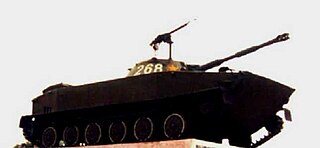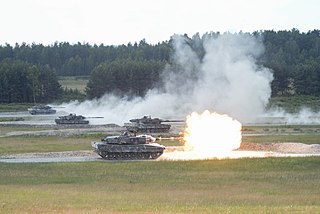Yasuoka Detachment or Yasuoka Task Force, was an armored Japanese Imperial Army unit in 1939. It was commanded by Lt. General Yasuoka Masaomi, composed of 3rd Tank Regiment and 4th Tank Regiment (seventy-three tanks total), 64th Infantry Regiment/IJA 23rd Division, 2/28th Infantry Regiment/IJA 7th Division, the 2nd Battalion of the 13th Field Artillery Regiment, and 24th Independent Engineer Regiment. It was an armored Detachment of the Kwantung Army organized for the Japanese July 1939 offensive of the Battle of Khalkhin Gol.
The Yasuoka Task Force planned to attack Soviet forces on the Halha's east bank, north of the Holsten River while simultaneously, the main force of the IJA 23rd Division would eliminate Soviet forces on the east bank and then cross to the west bank of the Halha River and drive south to the Kawamata Bridge, destroying Soviet artillery batteries and supply dumps along the west bank. The link-up of the two pincer columns in the vicinity of the Kawamata Bridge would encircle the Soviet forces and then destroy them.
The Japanese tank regiments operating on the east bank from July 2, separated and not coordinating with each other or their attached infantry, engineers and artillery failed to break through the Soviet defenses resulting in the loss of half their armor. On July 9 the Yasuoka Task Force was dissolved, Lt. General Yasuoka Masaomi was relieved and the Armour regiments withdrawn.

The Battles of Khalkhin Gol were the decisive engagements of the undeclared Soviet–Japanese border conflicts involving the Soviet Union, Mongolia, Japan and Manchukuo in 1939. The conflict was named after the river Khalkhin Gol, which passes through the battlefield. In Japan, the decisive battle of the conflict is known as the Nomonhan Incident after Nomonhan, a nearby village on the border between Mongolia and Manchuria. The battles resulted in the defeat of the Japanese Sixth Army.

The Type 94 tankette was a tankette used by the Imperial Japanese Army in the Second Sino-Japanese War, at Nomonhan against the Soviet Union, and in World War II. Although tankettes were often used as ammunition tractors, and general infantry support, they were designed for reconnaissance, and not for direct combat. The lightweight Type 94 proved effective in China as the Chinese National Revolutionary Army had only three tank battalions to oppose them, and those tank battalions were equipped only with some British export models and Italian CV-33 tankettes. As with nearly all tankettes built in the 1920s and 1930s, they had thin armor that could be penetrated by .50 caliber machine gun fire at 600 yards (550 m) range.

The Type 97 Chi-Ha was a medium tank used by the Imperial Japanese Army during the Second Sino-Japanese War, the Battles of Khalkhin Gol against the Soviet Union, and the Second World War. It was the most widely produced Japanese medium tank of World War II.

The Battle of Lang Vei began on the evening of 6 February 1968 and concluded during the early hours of 7 February, in Quảng Trị Province, South Vietnam. Towards the end of 1967 the 198th Tank Battalion, People's Army of Vietnam (PAVN) 202nd Armored Regiment, received instructions from the North Vietnamese Ministry of Defense to reinforce the 304th Division as part of the "Route 9-Khe Sanh Campaign". After an arduous journey down the Ho Chi Minh trail in January 1968, the 198th Tank Battalion linked up with the 304th Division for an offensive along Highway 9, which stretched from the Laotian border through to Quảng Trị Province. On 23 January, the 24th Regiment attacked the small Laotian outpost at Bane Houei Sane, under the control of the Royal Laos Army BV-33 "Elephant" Battalion.

Armoured warfare or armored warfare, mechanized warfare or tank warfare is the use of armoured fighting vehicles in modern warfare. It is a major component of modern methods of war. The premise of armoured warfare rests on the ability of troops to penetrate conventional defensive lines through use of manoeuvre by armoured units.

The Type 95 Ha-Gō was a light tank used by the Empire of Japan during the Second Sino-Japanese War, at Nomonhan against the Soviet Union, and in the Second World War. It proved sufficient against infantry but, like the American M3 Stuart light tank, was not designed to combat other tanks. Approximately 2,300 were produced, making it the most numerous Japanese armoured fighting vehicle of the Second World War.
Organization of the Kwantung Army which was an army group of the Imperial Japanese Army of Japan.

The Pennsylvania Army National Guard, abbreviated PAARNG, is part of the United States Army National Guard and is based in the U.S. Commonwealth of Pennsylvania. Together with the Pennsylvania Air National Guard, it is directed by the Pennsylvania Department of Military and Veterans Affairs. The PAARNG maintains 124 armories and is present in 87 communities across the Commonwealth.

The Type 89 medium tank I-Go was a medium tank used by the Imperial Japanese Army from 1932 to 1942 in combat operations of the Second Sino-Japanese War, at Khalkhin Gol against the Soviet Union, and in the Second World War. The Type 89B model was the world's first mass-produced diesel engine tank. The tank was armed with a short-barrel 57 mm cannon for knocking out pillboxes and masonry fortifications, and proved effective in campaigns in Manchuria and China, as the Chinese National Revolutionary Army had only three tank battalions to oppose them, which consisted primarily of Vickers export models, German Panzer Is, and Italian CV33 tankettes. The Type 89 was a 1920s design medium tank, built to support the infantry, and thus lacked the armor or armament of 1940s generation Allied armor; it was regarded as obsolete by the time of the 1939 battles of Khalkhin Gol, against the Soviet Union. The code designation "I-Go" comes from the katakana letter [イ] for “first” and the kanji [号] for "number". The designation is also transliterated Chi-Ro and sometimes "Yi-Go".
The 1st Tank Division, was one of four armored divisions of the Imperial Japanese Army in World War II.
The 2nd Division was an infantry division in the Imperial Japanese Army. Its tsūshōgō was Courageous Division.

Masaomi Yasuoka was a lieutenant general in the Imperial Japanese Army in World War II.
A combat command was a combined-arms military organization of comparable size to a brigade or regiment employed by armored forces of the United States Army from 1942 until 1963. The structure of combat commands was task-organized and so the forces assigned to a combat command often varied from mission to mission.
Battle of Chosin Reservoir order of battle is a list of the significant units that fought in the Battle of Chosin Reservoir between November 27, 1950 and December 13, 1950.

Takeshi Takashina was an Imperial Japanese Army general during World War II. He was killed in action during the Battle of Guam.

The Japanese invasion of Lingayen Gulf was the key point in the Japanese plan for the conquest of the Philippines. Preparations had already been made by the Attack on Clark Field and the landings of Japanese forces at five points in northern and southern Luzon and Mindanao in early/mid December 1941, with the IJAAF seizing air fields and basing aircraft for ground support, and the Imperial Japanese Navy establishing seaplane bases at the Camiguin Island, Legaspi, and Davao. The main landing of Japanese forces targeted Lingayen Gulf, with its proximity to the Philippine capital of Manila, and Lamon Bay on the opposite coast to the south.
The 3rd Tank Regiment was an armored regiment of the Imperial Japanese Army in World War II. It served in the China/Manchuria theater throughout the war.

The 21st Infantry Division was a division of the Philippine Army under the United States Army Forces in the Far East (USAFFE). The unit was involved in the delaying action against the Japanese invasion in the plains of Central Luzon, and the Battle of Bataan in 1942.
The 57th Rifle Division was an infantry division of the Red Army and the Soviet Army.